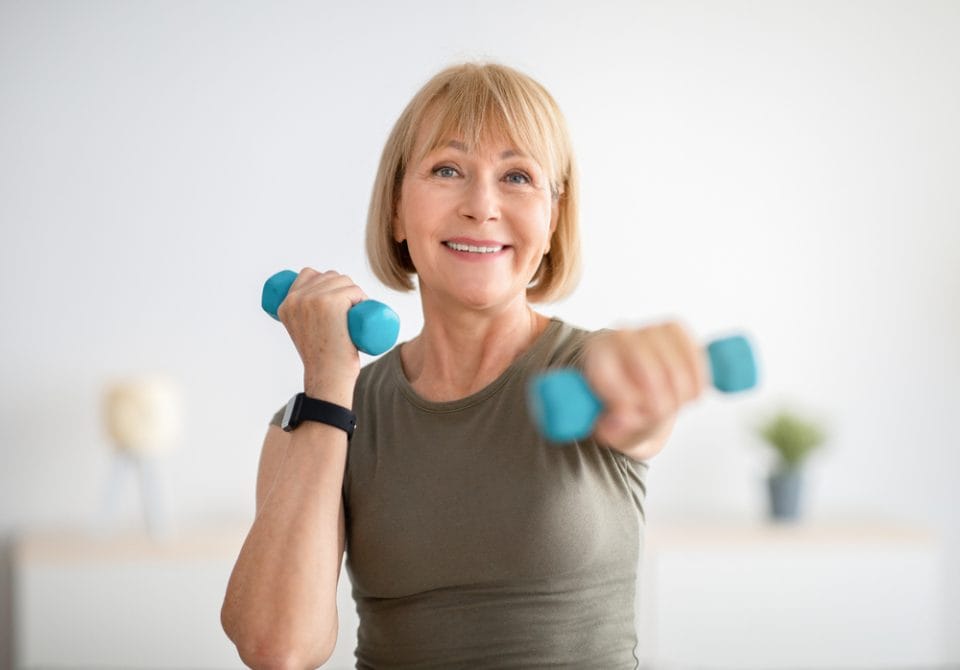According to one study, 78% of women experience unexpected improvements in sleep quality when they begin regular physical activity during their hormonal transition This statistic reveals just one of the many surprising benefits of exercise that extend far beyond typical weight management.
As a women’s health specialist, I’ve witnessed first-hand how this transformative period affects every aspect of your wellbeing. When I discuss fitness strategies with my patients, I often reveal benefits that genuinely surprise them.
Whilst many focus solely on maintaining their figure, the hidden advantages of regular movement during this hormonal shift are truly extraordinary. Through my clinical experience, I’ve discovered that physical activity serves as a powerful tool for managing complex symptoms.
From reducing hot flashes and stabilising mood swings to strengthening bone density and supporting cardiovascular health, the benefits are numerous. This guide will unveil these lesser-known advantages, providing you with evidence-based strategies to navigate this significant life stage with confidence and vitality.
Understanding Perimenopause and Its Impact on Women’s Wellbeing
In my clinical practice, I regularly encounter women navigating the complex changes of perimenopause. This natural biological process typically begins during your forties, though some women may experience it earlier. Perimenopause represents the transitional phase leading up to menopause, when your body gradually reduces hormone production.
During this significant life stage, your ovaries produce less oestrogen and progesterone. These hormonal shifts create a cascade of physical and emotional changes that affect women in midlife differently. The transition can last several years, making it essential to understand what’s happening to your body.
Common menopause symptoms during perimenopause include irregular periods, hot flushes, and mood fluctuations. You may also notice changes in your libido, decreased energy levels, and a gradual decline in muscle mass. Many women experience sleep disturbances and find their metabolism slowing down.
Vasomotor symptoms are prevalent during this time. Hot flushes, night sweats, and sudden flushing episodes can significantly impact your daily comfort and wellbeing. These symptoms occur because declining oestrogen levels affect your body’s temperature regulation system.
What many women don’t realise is that perimenopause and menopause affect multiple body systems simultaneously. Your cardiovascular health, bone density, and body composition all respond to these hormonal changes. Some women also experience vaginal dryness, which can affect intimate relationships and overall comfort.
I often explain to my patients that understanding these changes empowers you to take proactive steps. Recognising perimenopause as a natural transition helps you develop effective management strategies instead of simply enduring the symptoms. This knowledge becomes the foundation for making informed decisions about your health during this important life phase.
Surprising Mental and Cognitive Benefits of Exercise During Perimenopause
Exercise is a powerful ally for mental wellbeing during hormonal changes. I’ve seen remarkable transformations in my patients who exercise regularly during this phase. The psychological benefits often exceed their expectations entirely.
Physical activity acts as a natural antidepressant when hormones cause mood swings and anxiety. Exercise stimulates the release of endorphins, dopamine, and serotonin – your brain’s natural mood elevators. These neurochemicals combat the emotional turbulence many women face during perimenopause.
A 2016 study in Menopause Review showed significant mental health and vitality improvements after 12 weeks of exercise. The research found that regular exercise substantially enhanced overall wellbeing and reduced depressive symptoms in perimenopausal women.
Exercise also offers impressive cognitive benefits, helping to reduce brain fog and memory lapses. It increases blood flow to the brain and promotes neuroplasticity – your brain’s ability to form new connections. I’ve noticed that patients who exercise regularly experience sharper mental clarity and improved concentration.
You don’t need intense workouts to enjoy these mental health rewards. Moderate intensity exercise like brisk walking, swimming, or cycling can significantly boost your psychological resilience. Even 30 minutes of movement three times weekly can reduce anxiety and enhance cognitive function.
I always tell my patients that these lifestyle changes are more than just fitness goals. Exercise is essential medical advice for maintaining psychological health during perimenopause. The mental benefits create a positive cycle – improved mood makes it easier to stick with your routine, leading to continued wellbeing improvements.
Hidden Physical Health Advantages Beyond Weight Control
The most transformative effects of exercise during perimenopause occur beneath the surface, protecting your body in unseen ways. While weight management often dominates fitness discussions, I focus on the profound benefits that truly matter for your wellbeing.
Bone health preservation is the most critical advantage during this hormonal transition. As oestrogen levels decline, your risk of osteoporosis significantly increases. Weight-bearing and strenght training exercise provides the mechanical stress your bones need to maintain density and strength.
Walking, dancing, and resistance training effectively slow bone loss. These activities signal your body to build bone tissue, not break it down. Regular exercise helps patients maintain excellent bone density well into their seventies.
Your muscle mass also faces challenges during perimenopause. We lose approximately 5% of muscle tissue per decade after age 30. This loss accelerates during hormonal transitions, making strength training essential.
Preserving muscle strength supports far more than metabolism. Strong muscles maintain joint stability and functional independence as you age. They also burn calories even at rest, supporting your body’s natural energy balance.
Your cardiovascular system benefits greatly from regular activity. Research shows that moderate exercise just 2-3 times weekly can reduce heart disease and stroke risk by up to 30%. These protective effects develop gradually but create lasting improvements in heart health.
Exercise also improves insulin sensitivity during perimenopause. Blood sugar regulation often becomes problematic during hormonal changes. Regular physical activity helps your cells respond better to insulin, maintaining stable energy levels throughout the day.
These protective benefits compound over time, creating a foundation for healthy ageing. The cardiovascular disease prevention you build today protects you for decades ahead. The bone density you maintain now prevents fractures in your later years.
I tell my patients that these internal changes happen regardless of what the scales show. Your body strengthens from within, building resilience against age-related decline. This invisible transformation often proves more valuable than any visible changes you might notice.
Effective Exercise Strategies for Perimenopausal and Menopausal Women
I advocate for a multi-faceted exercise approach during perimenopause, focusing on both cardiovascular and muscular health. This strategy combines various training methods to maximise benefits during this transitional phase.
Cardiovascular exercise forms the foundation of any effective fitness programme. The North American Menopause Society recommends 150 minutes of moderate intensity activity weekly. This can include brisk walking, swimming, cycling, or dancing.
I encourage my patients to choose activities they genuinely enjoy. When exercise feels pleasurable, adherence improves dramatically. Even household activities like gardening or vigorous cleaning can contribute to your weekly cardio targets.
Strength training becomes absolutely essential during perimenopause. I recommend resistance exercises at least twice weekly, targeting all major muscle groups. This approach helps combat the natural muscle loss that accelerates during hormonal changes.
Your strength training can involve free weights, resistance bands, or bodyweight exercises like squats and push-ups. Weight-bearing activities provide additional bone density benefits, which becomes increasingly important as oestrogen levels decline.
High-intensity interval training offers remarkable benefits for metabolism and cardiovascular health. These workout sessions require just 15-20 minutes, making them perfect for busy schedules. HIIT alternates between intense bursts and recovery periods, maximising calorie burn both during and after exercise.
Flexibility and balance work through yoga or Pilates enhances joint mobility whilst providing stress-reduction benefits. These practices complement your cardio and resistance training beautifully, creating a well-rounded programme.
I always emphasise the importance of progressive overload. This means gradually increasing intensity, duration, or resistance to continue challenging your body. Your muscles and cardiovascular system need ongoing stimulus to maintain improvements.
Consistency trumps intensity every time. Three 20-minute sessions weekly will yield better results than sporadic hour-long workouts. I’ve seen patients achieve remarkable transformations with modest but regular exercise commitments.
Listen to your body’s signals and adjust your routine as needed. Energy levels and recovery needs may fluctuate during perimenopause. Some days you might feel energised for intense strength exercises, whilst others call for gentler movement like walking or stretching.
Remember that every woman’s journey through perimenopause is unique. What works brilliantly for one person might need modification for another. Start gradually and build your programme based on your current fitness level and personal preferences.
Overcoming Perceived Barriers to Exercise in Midlife
In my clinical practice, I’ve seen how perceived barriers to exercise stop many midlife women from staying active during perimenopause. These concerns are real and common among women going through this significant life change. The main obstacles include fatigue, joint pain, feeling self-conscious about fitness, and the daunting task of starting new routines.
Lack of time is a major worry for my patients. But, effective exercise doesn’t need long gym sessions or expensive gear. I suggest starting with just 10-15 minutes of daily activity. This could be a brisk walk, gentle stretching, or taking the stairs more often.
Setting realistic, achievable goals is key for perimenopausal and menopausal women starting their fitness journey. Your approach should align with your current lifestyle and energy levels, not demand drastic changes. Building sustainable habits takes time, so patience and self-compassion are vital for success.
Having backup plans is essential for staying consistent when life gets unpredictable. If your planned 30-minute workout is not possible, have a 10-minute alternative ready. Remember, some movement is better than none, and even light activity can improve mood and manage symptoms.
Address fatigue by exercising when your energy naturally peaks. Don’t be afraid to adjust activities based on how you feel. Any form of exercise that gets your body moving is beneficial during this transitional period.
The key is to change how you view physical activity. Focus on what your body can do, not what it can’t. Start small, celebrate your progress, and build confidence as you overcome perceived barriers to exercise.
Conclusion
Investing in exercise during midlife is a powerful move for your future wellbeing. The evidence shows that regular physical activity does more than just keep you fit. It offers menopausal women significant health benefits.
Exercise helps preserve bone density and muscle strength, and it supports heart health. These advantages are critical during perimenopause, when hormonal shifts can affect your body in unexpected ways.
See exercise as a form of medicine, not a chore. Whether it’s gentle walking or intense workouts, the aim is the same. It’s to keep a healthy weight and support your overall health. Combining exercise with a balanced diet is key to optimal wellness.
Your journey is unique. Some women may need hormone replacement therapy alongside exercise, while others find physical activity enough. The information provided should enhance, not replace, professional medical advice.
Always consult your healthcare provider before starting a new exercise routine, even more so if you have health conditions. They can help tailor a plan that meets your specific needs and circumstances.
Your perimenopausal journey doesn’t have to be endured. With the right approach to physical activity, you can flourish during this time and beyond.
FAQ: Exercise During Perimenopause
How many times a week should I exercise during perimenopause?
It is recommended to engage in physical exercise at least three times a week to help manage perimenopause symptoms.
What types of exercises are beneficial during perimenopause?
Weight-bearing exercise and vigorous exercise are important during perimenopause as they help strengthen muscle and bone, reducing the risk of osteoporosis in later years.
Can exercise help with menopausal symptoms?
Yes, exercise can help reduce menopausal symptoms such as hot flushes and night sweats, and it may also improve overall well-being.
Is it important for middle-aged women to maintain a healthy weight?
Maintaining a healthy weight is crucial for middle-aged women, especially during perimenopause and menopause, to reduce the risk of heart disease and other health issues.
How does exercise affect postmenopausal women?
For postmenopausal women, regular exercise can help improve cardiovascular health and maintain muscle strength, which is vital for overall health.
What is the risk of cardiovascular disease during perimenopause?
During perimenopause, women may experience an increased risk of cardiovascular disease, making physical exercise essential to help get your heart healthy.
How often should I aim to exercise for optimal health during menopause and beyond?
Aim for five times a week of moderate exercise to help maintain a healthy weight and improve overall health during menopause and beyond.
What health information should I be aware of during perimenopause?
It’s important to understand the changes your body goes through during perimenopause, including increased risk of osteoporosis and cardiovascular issues, and how exercise may mitigate these risks.
What exercises should I include in my routine?
Exercises include a mix of aerobic, strength training, and flexibility exercises to help manage symptoms and improve health.
Can exercise help improve mental health during perimenopause?
Yes, engaging in regular physical exercise can help improve mood and alleviate feelings of anxiety and depression that may occur during perimenopause.





